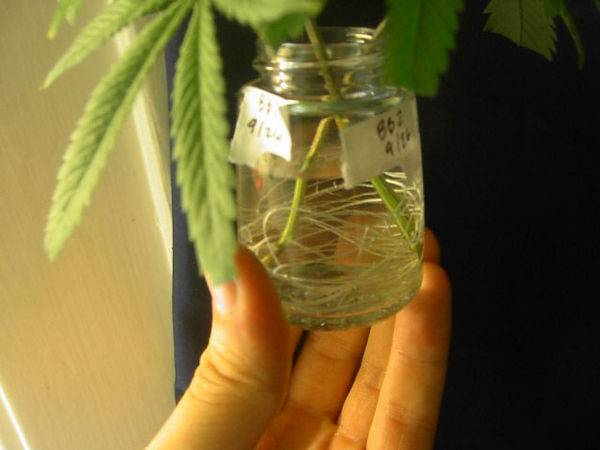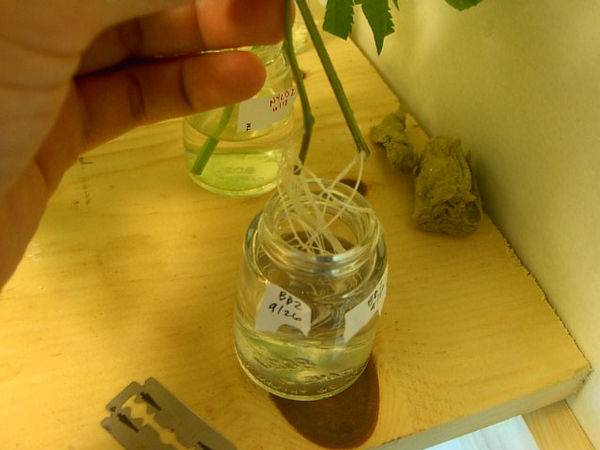G
Guest
This is a follow up to the piece I wrote for the FLower Pix News #6
http://www.icmag.com/ic/showthread.php?t=10530
I will go into more detail and include lots of pictures of each process I have found that water cloning facilitates.
I hope you find that sticking a cutting in a cup of water has a place in your room as well.
===============================
Unlike every other cloning method, water cloning requires no rooting hormone, humidity dome, ph check or specific kind of water to make it work. The cuttings snipped end is inserted in water and simply continues on as if nothing had happened, transpiring moisture through its leaves, keeping water pressure up the proper way, from stem to leaves, as oposed to artificial room humidity. Ph and water quality are similarly non issues because there is no root system to be affected by either factor.
Most cloning methods demand low light levels to keep your cutting in stasis. Water cloning is especially susceptible to light degradation. Excessive light will force any cutting to photosynthesize. Since the plant has no roots to support the growth this light tries to force, it will do what plants always do and begin draining the sugars stored in the leaves for food. The leaves will yellow and shrivel and eventually fall off the plant. When the leaves are all gone its unlikely your clone will survive. This response can also be seen in nutrient deficiencies and other problems with the plants medium and explains most yellowing seen in grow rooms today. Keeping light levels low and the plant in actual stasis will allow it to grow roots and keep almost all it's leaves green and healthy all the way to transplant. The very health of a fully green plant will somewhat mitigate the speed advantage other cloning methods have that end up with yellowed and withered leaves upon rooting. They still have to grow back those leaves that water cloning keeps.
this clone I kept in the water for a full two months. You can see it's huge and kept most of its green leaves and I can tell you it matured into a full sized plant just fine
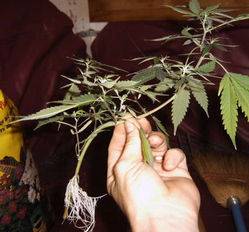
These are of some 12"+ cuttings I took, just to prove it could be done. The drawback is this clone took thre weeks to show roots. It's still not worth the time it takes to grow roots. If I could ever figure out a way to speed root development, the possibilities would be big.
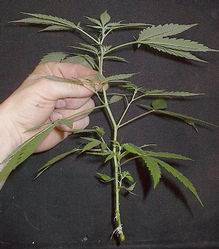
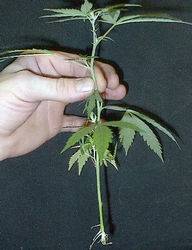
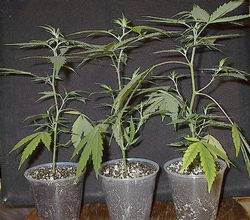
http://www.icmag.com/ic/showthread.php?t=10530
I will go into more detail and include lots of pictures of each process I have found that water cloning facilitates.
I hope you find that sticking a cutting in a cup of water has a place in your room as well.
===============================
Unlike every other cloning method, water cloning requires no rooting hormone, humidity dome, ph check or specific kind of water to make it work. The cuttings snipped end is inserted in water and simply continues on as if nothing had happened, transpiring moisture through its leaves, keeping water pressure up the proper way, from stem to leaves, as oposed to artificial room humidity. Ph and water quality are similarly non issues because there is no root system to be affected by either factor.
Most cloning methods demand low light levels to keep your cutting in stasis. Water cloning is especially susceptible to light degradation. Excessive light will force any cutting to photosynthesize. Since the plant has no roots to support the growth this light tries to force, it will do what plants always do and begin draining the sugars stored in the leaves for food. The leaves will yellow and shrivel and eventually fall off the plant. When the leaves are all gone its unlikely your clone will survive. This response can also be seen in nutrient deficiencies and other problems with the plants medium and explains most yellowing seen in grow rooms today. Keeping light levels low and the plant in actual stasis will allow it to grow roots and keep almost all it's leaves green and healthy all the way to transplant. The very health of a fully green plant will somewhat mitigate the speed advantage other cloning methods have that end up with yellowed and withered leaves upon rooting. They still have to grow back those leaves that water cloning keeps.
this clone I kept in the water for a full two months. You can see it's huge and kept most of its green leaves and I can tell you it matured into a full sized plant just fine
These are of some 12"+ cuttings I took, just to prove it could be done. The drawback is this clone took thre weeks to show roots. It's still not worth the time it takes to grow roots. If I could ever figure out a way to speed root development, the possibilities would be big.





